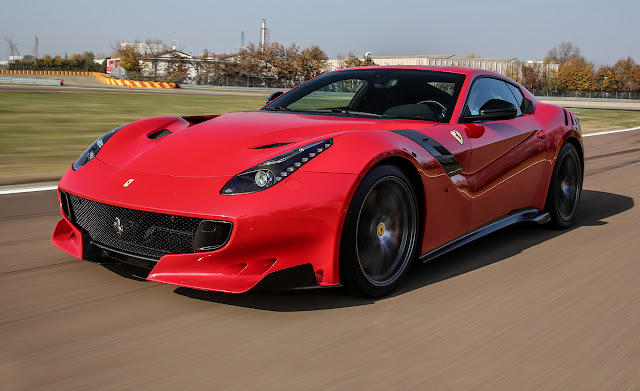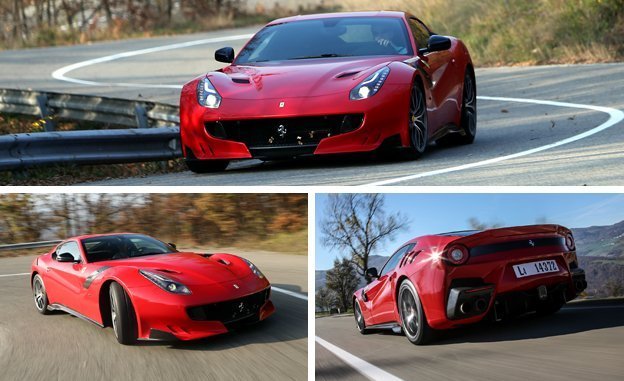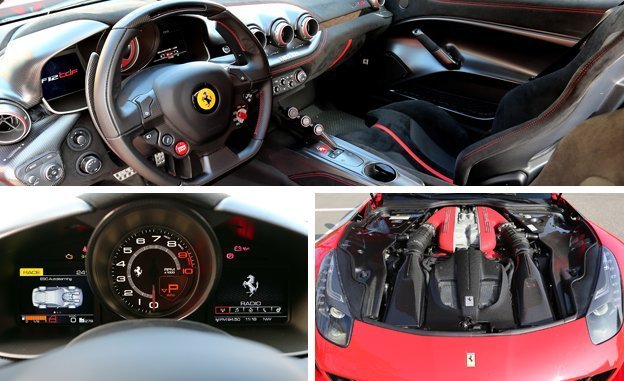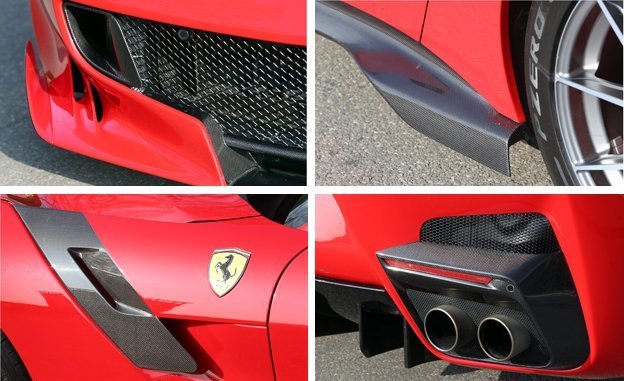To build its latest red-blooded creation, Ferrari first ruined a perfectly good car. In transforming the sure-footed F12berlinetta grand tourer into the fast-and-loose, apex-hounding F12tdf, Ferrari engineers deconstructed the stability that’s inherent in the F12’s long wheelbase, its substantial weight, and its high polar moment of inertia relative to mid-engined cars. The front tires grew in width from 255 millimeters to 285 millimeters, an aggressive alignment boosted turn-in and lateral grip, and—with no change to the rear tire width—a fickle, oversteering monster was born. One Ferrari chassis engineer described the team’s work bluntly: “First, we screwed up the car.”
With the chassis suitably squirrelly, engineers applied the brand’s first use of rear-wheel steering to dial in just enough stability to make the car manageable and predictable. Ferrari calls the resulting package Passo Corto Virtuale, or virtual short wheelbase, and it shrinks the F12tdf’s 107.1-inch wheelbase and 3600-pound curb weight to Miata-like sensations. Okay, maybe the F12tdf doesn’t drive quite that small and nimble, but it more than compensates with the uncanny precision that $490,000 buys.
Virtual Short Wheelbase, Real-World Awesome
The F12tdf worms its way into your psyche with delicate, light steering that is direct, immediate, and unforgiving. Spin the steering wheel too fast or too far and the rear responds just the same, rotating too fast or too far. Get it right, though, and the car darts where you look with the rear tires faithfully following the front end in a tight, tidy arc. It’s ironic that the steering feels like the most special of the F12tdf’s specialties, because while Ferrari massaged the F12’s engine, transmission, suspension, brakes, and aerodynamics for the F12tdf program, the hydraulically assisted steering system is the one component left unchanged.
The electric motors that steer the rear wheels at up to two degrees in either direction come from ZF, but Ferrari engineers performed all of the software calibration to ensure the system works in harmony with the electronically controlled limited-slip differential, the magnetorheological shocks, the traction control, and the stability control. As you click the steering-wheel-mountedmanettino drive-mode selector from Sport mode to Race to CT Off (traction control off), the car’s agility swells. Neutral is the wrong word, though, because neutral implies a car that can be provoked to understeer as readily as it oversteers. The F12tdf’s front tires only plow when you do something truly stupid.
Modern rear-wheel-steering systems, including those in the big-dog Porsche 911s, typically countersteer relative to the front wheels at low speeds to improve agility and steer in the same direction for greater stability at elevated velocities. Ferrari claims its adaptation doesn’t need to countersteer the rear wheels; the natural behavior of the car is sufficiently agile. Instead, the Italians need only the enhanced stability to keep the tail from overtaking the front of the car in corners.
Ferrari’s previous track special, the aptly named 458 Speciale, can turn any driver into a hero with its beautiful balance and unflappable cool. That mid-engined car’s reactions will flatter you into believing your every move is a flawless execution of vehicle-dynamics theory. The F12tdf is far less forgiving. It demands more focus, more skill, and more respect. In return, it delivers honest fun that is both uncommon and uncanny in a car with this much power and this much grip.
Oh, Did We Mention the 769-hp V-12?
Think of it as a testament to just how alive and intoxicating the chassis is that it’s taken some 550 words to get around to the 6.3-liter V-12, because the drama of unleashing all 769 horsepower is man’s greatest tribute to the internal-combustion engine. At full throttle, it bellows like a thousand angelic trumpets ushering you into car-guy heaven as the revs wind up like a crotch rocket’s.
The F12tdf musters an additional 39 horsepower and 11 lb-ft of torque over the standard F12 with the help of a new air-filter box, revised intake plumbing, and a larger throttle body. Solid lifters replace hydraulic tappets. The resulting weight reduction allows Ferrari to add more valve lift to the intake-cam profile and to raise the rev limiter from 8700 rpm to 8900 rpm. Variable-length intake runners use telescoping trumpets within the intake plenum to shrink or stretch the runner length for optimized airflow. In the F12tdf, Ferrari uses just two distinct positions—short and long—but future cars may take advantage of the fact that the position of the trumpets is continuously variable between the boundary conditions.
Shorter gear ratios throughout the seven-speed dual-clutch automatic transaxle are augmented with quicker shift times. We project a 2.8-second blast to 60 mph on the way to a 10.8-second assault on the quarter-mile. The always-on nature of the big-displacement, naturally aspirated 12-cylinder engine demands a delicate right foot on corner exit, but the pedal obliges with long, linear travel. When it’s time to reverse thrust, a brake pedal with just as much fidelity activates a carbon-ceramic braking system borrowed from the LaFerrari hypercar.
Lighter, But Still Luxurious
Ferrari intends the F12tdf to be a car that owners will drive to the track, at the track, and back home from the track. But in readying the F12 for regular track service, the suspension has lost some suppleness. Even with the dampers set to their more compliant mode, the F12tdf skims over humps in the road like a skipped rock. In city driving, the F1 dual-clutch transmission isn’t as velvety as Porsche’s or McLaren’s gearboxes, particularly in off-throttle downshifts. Overall, though, the F12tdf remains a civilized road car. While lighter microsuede replaces leather and carpets have been removed altogether, Ferrari still fits a radio, navigation, and air conditioning.
Ferrari stripped a total of 243 pounds from the F12. A chunk of that weight comes from reducing the amount of glass on the car by tapering the rear window and shrinking the rear-quarter windows until the transparent section is no larger than an iPhone. Carbon fiber is now used for the door skins inside and out, plus the front and rear fascias. And while the rest of the body panels are still aluminum, the roof and the A-pillars are the only pieces that carry over from the F12. The bevy of dive planes, spats, and spoilers increase downforce to more than 500 pounds at 124 mph. While they’re added for functional purposes, the cooling and aerodynamic changes also create something visually striking. The righteous louvered fenders bulging around the rear tires are both an homage to classic Ferraris and a carnal suggestion of what the car is capable of. Ferrari may have taken one step backward to start work on the F12tdf, but its finished product is miles ahead of the F12 in driving excitement.












0 commentaires:
Enregistrer un commentaire